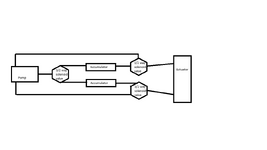I don't understand your explanation. Flow-direction arrows and schematics indicating what is happening when, would help.
BUT. Three directional valves and two accumulators to control one cylinder? I understand it needs "forward", "stop", and "retract". If you have a single source of pressure (whether fitted with an accumulator or otherwise), a single directional valve, dual solenoid spring-centered with a closed-center spool, is all that is needed. Pressure to the center port, A and B to the ends of the cylinder, return-to-tank from the end ports (and the reservoir is the atmospheric-pressure reservoir for the pump). The pump needs to deal with being deadheaded appropriately. This layout is "fixed pressure variable displacement". This is a very common general-purpose hydraulic circuit design. Your average plain old ordinary industrial machine with a hydraulic power unit and a bank of directional valves to move various hydraulic functions, works like this.
Saving energy in that type of hydraulic circuit design generally means using a variable-displacement pump, so that you can turn it down to zero displacement when there is no demand. It still needs to maintain regulated pressure to achieve the maximum force on the actuator. This is not an inexpensive fixed-displacement gear pump. It's a variable-displacement vane or swash-plate pump. $$$, although lots of automotive engine oil and transmission oil pumps are variable-displacement vane pumps nowadays.
The other choice of hydraulic circuit design is something akin to old skool power steering systems, with a fixed-displacement engine driven pump (cheap, simple) delivering constant circulation through an open-center spool valve. Your input at the steering wheel shifts the valve which causes the pressure to build up in one side or the other, sufficient to overcome the load of the steering gear. "Fixed displacement and variable pressure". Doesn't work with an accumulator. If you insist on having a circuit design with momentary hydraulic flow into the cylinder that exceeds the instantaneous flow rate of the pump (thus needing an accumulator to store the pressure) then you're stuck with a fixed-pressure circuit design (with the pressure setpoint being whatever the storage pressure in your accumulator is).
If energy-conservation is a consideration, then hydraulics are not a good choice. Similar applications nowadays use a little stepper or servo motor to a gearbox to what amounts to a screw jack. No hydraulics. No standby power loss. Same reason power-steering systems have almost all gone to electric-servo nowadays.


